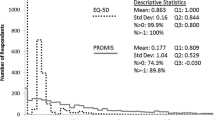Abstract
The choice of instrument (e.g. EQ-5D vs. SF-6D) can lead to different health-related utility scores, but it is unclear why these differences arise and whether they change cost utility analysis (CUA) results. This paper addresses these issues using a case study where using SF-6D rather EQ-5D led to greater utility gain and a lower cost per QALY for treatment. The paper examines reasons for this difference. This paper finds that an important factor was the inclusion in the SF-6D descriptive system of separate items for “vitality” and “social functioning”, not explicitly included in EQ-5D. Further studies are required that examine the impact of the choice of instrument on cost-utility.

Similar content being viewed by others
References
Barton, G.R., Bankart, J., Davis, A.C., Summerfield, Q.A.: Comparing utility scores before and after hearing-aid provision: results according to the EQ-5D, HUI3 and SF-6D. Appl. Health Econ. Health Policy 3(2), 103–105 (2004)
Bharmal, M., Thomas, J. 3rd.: Comparing the EQ-5D and the SF-6D descriptive systems to assess their ceiling effects in the US general population. Value Health 9(4), 262–271 (2006)
Boonen, A., van der Heijde, D., Landewe, R., van Tubergen, A., Mielants, H., Dougados, M., van der Linden, S.: How do the EQ-5D, SF-6D and the well-being rating scale compare in patients with ankylosing spondylitis? Ann. Rheum. Dis. 66(6), 771–777 (2007)
Brazier, J., Roberts, J., Deverill, M.: The estimation of a preference-based measure of health from the SF-36. J. Health Econ. 21, 271–292 (2002)
Brazier, J., Roberts, J., Tsuchiya, A., Busschbach, J.: A comparison of the EQ-5D and SF-6D across seven patient groups. Health Econ. 13, 873–884 (2004)
Bryan, S., Longworth, L.: Measuring health-related utility: why disparity between EQ-5D and SF-6D? Eur. J. Health Econ. 6, 253–260 (2005)
Dolan, P.: Modelling valuations for EuroQol health states. Med. Care 35, 1095–1108 (1997)
Fisk, J.D., Brown, M.G., Sketris, I.S., Metz, L.M., Murray, T.J., Stadnyk, K.J.: A comparison of health utility measures for the evaluation of multiple sclerosis treatments. J. Neurol. Neurosurg. Psychiatry 76, 58–63 (2005)
Fried, M.W., Shiffman, M.L., Reddy, K.R., Smith, C., Marinos, G., Goncales, F.L. Jr., et al.: Peginterferon alfa-2a plus ribavirin for chronic hepatitis C virus infection. N. Engl. J. Med. 347(13), 975–982 (2002)
Grieve, R., Roberts, J., Wright, M., Sweeting, M., De Angelis, D., Rosenberg, W., Bassendine, M., Main, J., Thomas, H.: Cost effectiveness of interferon alpha or peginterferon alpha with ribavirin for histologically mild chronic hepatitis C. Gut 55, 1332–1338 (2006)
Lamers, L.M., Bouwmans, C.A.M., van Straten, A., Donker, M.C.H., Hakkaart, L.: Comparison of EQ-5D and SF-6D utilities in mental health patients. Health Econ. 15, 1229–1236 (2006)
Longworth, L., Bryan, S.: An empirical comparison of EQ-5D and SF-6D in liver transplant patients. Health Econ. 12, 1061–1067 (2003)
Manns, M.P., McHutchison, J.G., Gordon, S.C., Rustgi, V., Shiffman, M., Reindollar, R., et al.: PegInterferon alfa-2b plus ribavirin compared to interferon alfa-2b plus ribavirin for initial treatment of chronic hepatitis C: a randomised trial. Lancet 358(9286), 958–965 (2001)
Mara, C.A., Woolcott, J.C., Kopec, J.A., Shojania, K., Offer, R., Brazier, J.E., Esdaile, J.M., Anis, A.H.: A comparison of generic, indirect utility measures (the HUI2, HUI3, SF-6D, and the EQ-5D) and disease-specific instruments (the RAQoL and the HAQ) in rheumatoid arthritis. Soc. Sci. Med. 60, 1571–1582 (2005)
Michaels, J.A., Campbell, W.B., Brazier, J.E., Macintyre, J.B., Palfreyman, S.J., Ratcliffe, J., Rigby, K.: Randomised clinical trial, observational study and assessment of cost-effectiveness of the treatment of varicose veins (REACTIV trial). Health Technol. Assess. 10(13), 1–196 (2006)
National Institute for Clinical Excellence: Guide to the Methods of Technology Appraisal. NICE, London (2004)
Pickard, S.A., Wang, Z., Walton, S.M., Lee, T.A.: Are decisions using cost-utility analyses robust to the choice of SF-36/SF-12 preferenced-based algorithm? BMC Health Qual. Life Outcomes 3, 1–9 (2005)
Stavem, K., Frøland, S.S., Hellum, K.B.: Comparison of preference-based utilities of the 15D, EQ-5D and SF-6D in patients with HIV/AIDS. Qual. Life Res. 14, 971–980 (2005)
Tidermark, J., Bergström, G., Svensson, O., Törnkvist, H., Ponzer, S.: Responsiveness of the EuroQol (EQ 5-D) and the SF-36 in elderly patients with displaced femoral neck fracture. Qual. Life Res. 12(8), 1069–1079 (2003)
Tsuchiya, A., Brazier, J., Roberts, J.: Comparison of valuation methods used to generate the EQ-5D and the SF-6D value sets. J. Health Econ. 25, 334–346 (2006)
van den Hout, W.B., de Jong, Z., Munneke, M., Hazes, JMW., Breedveld, F.C., Vliet Vlieland, T.P.M.: Cost-utility and cost-effectiveness analyses of a long-term, high-intensity exercise program compared with conventional physical therapy in patients with rheumatoid arthritis. Arthritis Rheum. 53, 39–47 (2005)
van Stel H.F., Buskens, E.: Comparison of the SF-6D and the EQ-5D in patients with coronary heart disease. Health Qual. Life Outcomes 4, 1–9 (2006)
Xie, F., Li, S.C., Luo, N., Lo, N.N., Yeo, S.J., Yang, K.Y., Fong, K.Y., Thumboo, J.: Comparison of the EuroQol and short form 6D in Singapore multiethnic Asian knee osteoarthritis patients scheduled for total knee replacement. Arthritis Rheum. 57(6), 1043–1049 (2007)
Wee, H.L., Machin, D., Loke, W.C., Li, S.C., Cheung, Y.B., Luo, N., Feeny, D., Fong, K.Y., Thumboo, J.: Assessing differences in utility scores: a comparison of four widely used preference-based instruments. Value Health 10(4), 256–265 (2007)
Wright, M., Grieve, R., Roberts, J., Main, J., Thomas, H.C., UK Mild Hepatitis C Trial Investigators: Health benefits of antiviral therapy for mild chronic hepatitis C: randomised controlled trial and economic evaluation. Health Technol. Assess. 10(21), 1–113 (2006)
Author information
Authors and Affiliations
Corresponding author
Rights and permissions
About this article
Cite this article
Grieve, R., Grishchenko, M. & Cairns, J. SF-6D versus EQ-5D: reasons for differences in utility scores and impact on reported cost-utility. Eur J Health Econ 10, 15–23 (2009). https://doi.org/10.1007/s10198-008-0097-2
Received:
Accepted:
Published:
Issue Date:
DOI: https://doi.org/10.1007/s10198-008-0097-2




